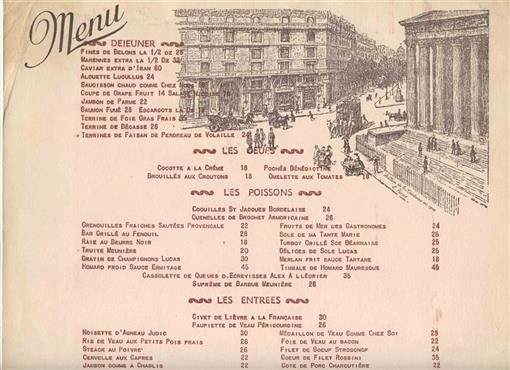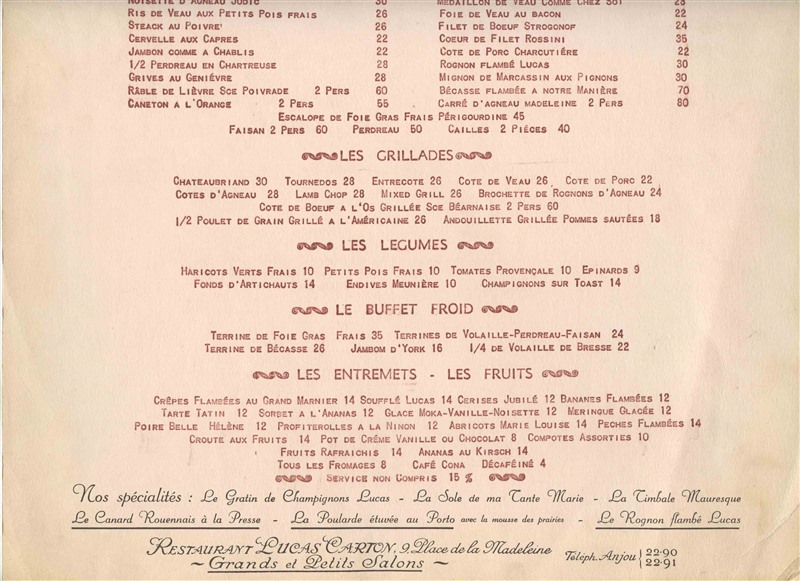Lucas Carton Menu 3 Michelin Stars Place de la Madeleine Paris France 1970's


A very large single page menu with a drawing of the Restaurant Lucas Carton and the L'église de la Madeleine. A Restaurant Lucas Carton Menu, located on the Place de la Madeleine in Paris France. Circa 1970's. Measures about 11 3/4" x 17" and the back is blank. Priced in Francs. The Restaurant where Chef Alain Senderens returned his 3 Michelin Stars
Due to the size limitations of my scanner, the entire menu may not show in some of the scans.
The official inauguration of the restaurant dates back to the construction of thebuilding by the architect Charpentier in 1839.But it wasn’t until 1860, when it was christened “La Taverne de France” bythe new owner MrAugis, that it become the “place to be” for Napoleon III’sParisian elite. In 1880, Augis’ successor, Scaliet, made the restaurant what it is today bynaming it “Lucas”, and most importantly by ordering from Majorelle thesculpted woodwork which adorns the restaurant, turning it into an Art Nouveauchef-d’oeuvre which enticed art-lovers from all over the world. In the interwar period, Mr Carton purchased the restaurant and added hissurname to the name already above the door. Since 1924, Lucas Carton has satopposite the Madeleine Church.
Alain Senderens, who has died aged 77, was one of a small group of French chefs whose nouvelle cuisine transformed European cooking in the late 1960s and early 70s, not only by the rejection of elaborate dishes heavily doused with cream, fats and flour-thickened sauces, but also by their declaration of the independence of the chef-patron, and their willingness to absorb ideas from sometimes alien cultures. In 1985, moving from his small restaurant, L’Archestrate (named after the ancient Greek gastronomic poet Archestratus), Senderens took by storm one of those citadels of the old ways of cooking, the restaurant Lucas Carton on the Place de la Madeleine, which had served Paris since 1860. However, he shocked the gastronomic establishment in 2005 by “returning” his three Michelin stars and transforming the restaurant, of which he now had sole ownership and which he rechristened Senderens, into somewhere that served food of the highest quality, but without the “tra-la-las and chichi” of high-end dining. Advertisement He suggested people should see what he could do with sardines: quite as exciting as a piece of prime turbot. He embraced the idea of food for the many, not the few. Prices fell from crazily high to just high (from €400 to around €100 per person ). This was to carry through to his involvement with several unorthodox but democratising ventures: his own Bar le Passage above Lucas Carton, and the Paris branch of the modish hotel group Mama Shelter, which opened in 2008, designed by Philippe Starck and located by the Père Lachaise cemetery. It also informed his early cooperation with the Carrefour supermarket chain in developing foods for the home shopper. Quite early in his independent career, he had made friends with the chef Michel Guérard, who was following a similar style of innovative cookery in his bistro Le Pot-au-Feu in the suburbs of Paris, which he had started in 1965. Guérard introduced him to that small group of like-minded people, including Alain Chapel, the Troisgros brothers and Paul Bocuse, who were the beating heart of nouvelle cuisine. From the outset, his cooking attracted notice: a salad of lobster with peaches, and oysters cooked with leeks gained him a Michelin star in L’Archestrate’s first year; within 10 years he had three stars. Sign up for Word of Mouth: the best of Guardian Food every week Read more More than any of his peers, Senderens was open to new flavours from abroad and to revisiting the culinary possibilities of past masters. Trips to the far east led to the introduction of Thai spices and soy sauce to his store cupboard, as well as new combinations of sweet and savoury (think here of his matchless combination of lobster with vanilla) and the influence of Japanese sensibilities in his presentation. Extensive reading was behind his most famous creation, duck Apicius with honey and spices served with apple cooked with saffron and dates stuffed with fresh mint, which came from a Roman cookery book. His great innovation at Lucas Carton, first seen in 1987, was a tasting menu where the choice of the wine determined the nature of the food. Spurred perhaps by Guérard’s criticism of the wine list at L’Archestrate, and under the influence of the wine expert Jacques Puisais, Senderens had embarked on a voyage of discovery through the vineyards of France as well as the departments of oenology of its universities. His wine choices were by no means conventional: a sweet white wine with the duck Apicius and a white Vouvray with goat’s cheese. This ability to revivify a diner’s experience kept Lucas Carton high in esteem, always with three Michelin stars until he handed them back 30 years later. Senderens was born in Hyères on the Côte d’Azur, in the south of France, his father, René, a barber, his mother, Lucette (nee Azan), a dressmaker. The family moved to the Pyrenees before Alain started school in the village of Labatut-Rivière, progressing to the lycée at Vic-en-Bigorre. Inspired to cook by his grandmother’s example, in 1957 he went to Lourdes as an apprentice chef at the Hôtel des Ambassadeurs, whence he was able to graduate to the more serious Parisian kitchens of the Tour d’Argent and Lucas Carton (where he was chef saucier). Following a year at Le Berkeley restaurant in Paris, he was hired as sous chef at the Orly Hilton hotel before opening L’Archestrate, not far from the Eiffel Tower, in 1968. The restaurant moved to larger premises in the Rue de Varenne in 1971. Éventhia Pappadinas, whom he married in 1974, was always involved in his restaurants, from the very first days looking after the seven small tables at L’Archestrate. Senderens maintained that his signature dish of a whole truffle baked within a bread roll was invented for his marriage to Éventhia, who preferred truffles to any other food. Senderens wrote several books, some of which have been translated into English. His most successful include La Cuisine Réussie, with Éventhia, in 1981 (published in Britain as The Cuisine of Alain Senderens); La Grande Cuisine à Petits Prix (1984); and Alain Senderens et Jérôme Banctel dans Votre Cuisine (2012). His columns in L’Express magazine were translated in the US as The Table Beckons: Thoughts and Recipes from the Kitchen of Alain Senderens (1993). Among many other awards he was made officer of the Légion d’Honneur in 2004. In 2013 he sold his interest in Senderens the restaurant, now back again as Lucas Carton, to the proprietors of Pommery Champagne, and retired to the Corrèze, east of Limoges – although not before guiding, in an advisory role, the new team on to proper lines. He is survived by Éventhia and their son.
Our Policies:
For Multiple Purchases A single payment for all items would be appreciated.
We Ship World Wide Due to the Pandemic and the Impact of USPS Policy Changes, Delivery time of some International Packages may be 8 to 18 weeks or more
International Buyers – Please Note:
Import duties, taxes, and charges are not included in the item price or shipping cost. These charges are the buyer's responsibility.
Please check with your country's customs office to determine what these additional costs will be prior to bidding or buying.
STATE Sales Tax Based on Applicable Tax Laws, eBay will calculate and, collect Sales Tax for items shipped to customers in States requiring Sales Tax collection.
You may be interested in our other eBay listings.

Powered by SixBit's eCommerce Solution